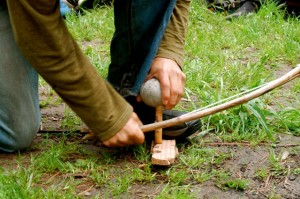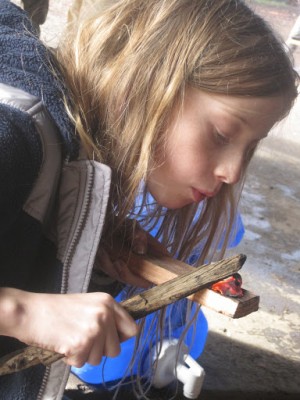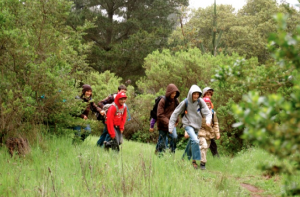A Critical Time for Jewish Youth: Rethinking the Bar and Bat Mitzvah
Again and again, we’re seeing the bar and bat mitzvah fail to address the urgent needs teens face today. While current bar and bat mitzvahs often provide a meaningful initiation into Judaism, preparing children to perform the Saturday morning service and read Torah, they often fall short of meeting youth where they’re at. We face a critical time on earth, and youth are facing challenging messages in modern culture as they are forming their identities. It is more important than ever to provide support for our youth as they move toward adulthood. While Jewish tradition can provide a basket of support and values that can carry our youth through this time, all too often, we miss the mark when it comes to making Judaism relevant in their lives or providing a Jewish compass to navigate their lives ahead.
Jewish parents, educators and leaders are now asking important questions about how to use this rite of passage to effectively engage Jewish youth in Judaism, questions about whether the way we mark this occasion meets the needs of our youth and greater community. The problems of a party-centric approach, or overemphasizing the ritual itself, came up repeatedly at this year’s Jewish Futures Conference, focused on the “Role of the Bar and Bat Mitzvah in America Today”. People across the Jewish world are waking up to see that we are missing a key opportunity for this transition to be meaningful and transformative.
A spate of recent studies illuminate the concern felt in the room during the conference. Upward of 60 percent of Jewish youth consider bar and bat mitzvahs the end — not the beginning — of a Jewish journey, because it doesn’t speak to them personally. A Brandeis University study, “Being a Jewish Teenager in America: Trying to Make It,” concluded that the b’nai mitzvah essentially fails to meet the real-world needs of adolescents, particularly in its failure to empower adolescents with more responsibility in their lives.
The b’nai mitzvah comes at the end of childhood when, ideally, youth begin to discover their individual gifts, venture further from the safety of the nest, take more responsibility and learn to make their own choices. If we want youth to succeed, we must make sure they have access to the physical, psychological, and spiritual tools necessary for a safe passage into their teen years.
So, how to address this meaningfully? In “Redesigning Jewish Education for the 21st Century,” Jonathan Woocher concludes that we can remedy this with “life-centered” approaches that are relevant to students’ lives. This necessitates creating programs that provide embodied experiences informed by Jewish tradition that allow for valuable life lessons to be learned. Experiences that involve physical challenges, doing things beyond one’s previous ability, being part of a community and working with others all create fertile ground for these lessons to be learned.
Meet Youth Where They Are
While we think about the next generation of Jewish youth, we can draw inspiration from other cultures that have made this transition meaningful and relevant. After all, this transition has been happening since the beginning of human history — and tribes throughout the world have designed processes for a safe passage through what can be the most precarious threshold of a person’s life.
What does it mean, then, to meet a child at the threshold of adolescence? It means giving them tools and trials that mirror the challenges of pending adulthood, preparing them to thrive in their new adult lives, which benefits the individual while helping to ensure the resiliency of the entire community.
But how? As we explored different approaches to answering the call for “life-centered” bar and bat mitzvah education, we found a few universal elements that support the transition into becoming a responsible, healthy teenager.
1. The Wilderness: Judaism is an ancient, indigenous tradition. Our entire Torah narrative revolves around our experiences in the wilderness. Reconnecting to these ancient roots is essential. Take the story of Avram, for example, who was instructed to leave his family and go to himself. Avram’s story is the first archetypal rite of passage — leave home so you can find your own path. And where does Avram go after leaving home? He first visits Alon Moreh, Hebrew for “teacher tree,” where he then receives his vision (Genesis 12:6).
Moses learns of his mission while in the wilderness alone. Miriam encounters the well of water only after arriving in the wilderness. Jacob receives his new name, Israel, during a wilderness solo of his own. The Torah teaches us over and over that we find ourselves and our mission in the mirror of nature. Especially during this time when our youth spend more time on cell phones and computers, it is critical to give them undistracted time to connect to what is real in the natural world.
2. Edge Experiences: To grow out of being a child, one must take risks to test one’s own power and discover one’s own limits. The wilderness provides a perfect venue to push the edges of our youth through activities like a night swim in a cold pond, lighting and tending fire, sitting alone in nature, and traveling through the dark of night. Well-designed edge experiences provide opportunities to transcend one’s limited beliefs and discover new possibilities.
3. Mentorship: The role of parents is to raise and protect children. Parents cannot raise children alone, which is where mentors come in. Children thrive when adults they admire guide them and invite them on exciting, challenging experiences that awaken their innate curiosity and passions.
4. It Takes a Village: For people to grow successfully into their next developmental stage, they need community support and guidance. Witnessing and reflection from others around them allows them to better see themselves and fully grow into a new life.
5. Honoring the Different Needs of Girls & Boys: At this age, boys and girls tend to enter into different processes of physical and emotional transformation. Having a safe space to explore these changes is a critical part of coming of age, while being mindful to create skill building and challenge opportunities that avoid outdated gender stereotypes.
Taking Kids to the Edge, Embracing Ancient Wisdom
For thousands of years in cultures the world over, rites of passage brought children into the next phase of their lives with self-awareness and confidence, in part by recognizing how integral these core elements are.
Joseph Campbell masterfully describes the mythological “hero’s journey” on which each of us must embark to make the passage into our true adulthood. We must shed the old life that has become too small and go through an “ordeal” to claim our gifts and step onto this new path.
Pushing boundaries epitomizes this time of transition. This is a time of differentiation from parents, whose primary role is to rear and protect their children. In healthy indigenous cultures throughout time, non-parental mentors would take youth away from their parents — taking them “to the edge” in safe and healthy ways.
Without such support, modern teens unconsciously seek initiation through precarious behaviors such as high-risk sports or explorations of drugs, alcohol, and unsafe sexual activity. Ask parents about the transition from childhood to adolescence, and odds are you’ll hear about a descent into pop culture and peer pressure that leaves them feeling alienated as their loving, creative children become aloof, disconnected teenagers.
By providing meaningful experiences that help teens develop the confidence and skills they need to be independent individuals, we can help our youth avoid fulfilling the modern American stereotype: rebellious, rude, unmoored, and untrustworthy.
Wilderness Torah has developed one approach to re-connecting Jewish youth to a life-centered rite-of-passage through B’naiture, a two year Jewish nature-based mentorship that culminates in an overnight wilderness solo where youth kindle and tend their own fire. We have witnessed this transform their lives, giving youth more confidence and grace, and a deeper sense of pride in their ancestral heritage.
Young people are excited to be given challenges and opportunities to explore their own gifts and edges, while parents are proud witnesses to the lasting impact of their children’s positive transformations. Who wouldn’t be pleased to find their child “more grounded, taking more initiative, and more aware of the world around him,” as one father described the changes he witnessed in his son through his experience in B’naiture.
Drawing from our ancient wellspring of Jewish teachings, and lessons from other indigenous cultures around the world, it is now time to embrace this new–old way of supporting and mentoring our youth into a successful future. When youth are truly met where they are at in this crucial life stage, we will see respectful, communicative, and helpful youth who find meaning in lighting Shabbat candles and grow into adults who have the confidence and awareness to live a life of tikkun olam, true service to humanity.
A community maggid, wilderness guide, youth mentor, environmental educator, and attorney, Zelig Golden brings over a decade of visionary leadership to the Jewish environmental movement. Sarai Shapiro is dedicated to creating culture that connects people, the earth, and spirit. She directs Wilderness Torah’s youth programs.
**Like this article? Read Zelig’s Zeek article on “Earth-based Judaism: Reclaiming Our Roots, Reconnecting to Nature.” And Sarai’s piece on “The Jewish Medicine Wheel.”
![[the current issue of ZEEK]](../../image/2/100/0/5/uploads/leftistethicistgraphic-52842c6a.png)
- 5000 Pages of Zeek
- Founded in 2001, Zeek was the first Jewish online magazine, and we have over 5000 pages online to prove it, all available free of charge. Read more in the Archive.
More articles by
Sarai ShapiroZelig Golden
More articles in
Faith and Practice
- To-Do List for the Social Justice Movement: Cultivate Compassion, Emphasize Connections & Mourn Losses (Don’t Just Celebrate Triumphs)
- Inside the Looking Glass: Writing My Way Through Two Very Different Jewish Journeys
- What Is Mine? Finding Humbleness, Not Entitlement, in Shmita
- Engaging With the Days of Awe: A Personal Writing Ritual in Five Questions
- The Internet Confessional Goes to the Goats




